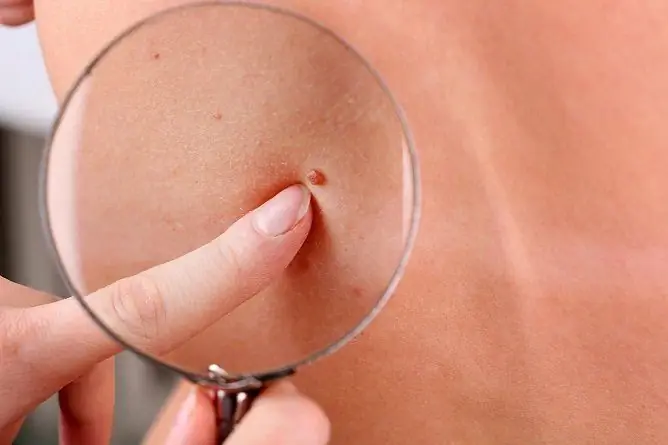- Author Rachel Wainwright [email protected].
- Public 2024-01-15 19:51.
- Last modified 2025-11-02 20:14.
Papillomas on the body
The content of the article:
- The reasons
- External manifestations
-
How to get rid of papillomas
- Destruction methods
- Folk remedies
- Video
Papillomas on the body are benign formations of an infectious nature. Strains 16 and 18 tend to degenerate into malignant forms (more than 100 species are known in total). Wart and papilloma are synonymous terms.
Features of the disease:
- It occurs in people of any age, mainly in women (the number of detected cases is 1.5 times higher than in men).
- Infection occurs through household contact or sexually. It goes unnoticed for a long time, since the virus does not have a strong effect on the immune system. In addition, after being introduced into the genome, only the viral DNA remains, and not the virus itself (it is almost impossible to remove it).
- There are a number of vaccines designed to reduce the number of infections and reduce susceptibility to the viral agent.
- Immunity after the transferred infection is formed as a type-specific, non-cross, non-tense, low, which means the possibility of repeated infections.

Papillomas on the body are caused by infection with the human papillomavirus (HPV)
The reasons
The main reason for the appearance of papilloma on the body is the human papillomavirus (HPV, papillomavirus). It belongs to DNA-containing viruses, which explains its ability to integrate into the human genome and change its structure. The virus enters the bloodstream through microdamages and settles on the basal layer of the epidermis. Division occurs only at the level of the germ layer, in the rest the virus can be detected, but there is no division at these levels.
There are several clinical forms of the disease:
- manifest - primary infection with the virus in persons with reduced immunity;
- subclinical - a form in which manifestations of this pathology periodically occur, followed by long-term relapses;
- latent - a form associated with the direct integration of the virus into the genome (carrier).
Predisposing factors in the development of neoplasms:
- Skin damage. The virus is unable to enter the bloodstream without at least minimal trauma to the skin, which serves as the entrance gate of the infection.
- Reduced immunity. HPV can be classified as a conditionally pathogenic virus, which makes it dangerous for humans if the normal cellular or humoral immune response is suppressed.
- Failure to comply with hygiene rules when visiting public places. The virus is contagious, and infection can occur even at low concentrations in the environment.
- Violation of the normal diet, constant stress and lack of adequate rest lead to suppression of the immune system, the body becomes vulnerable to the action of the pathogen.
- Frequent inflammatory and infectious diseases lead to a depletion of the immune system (this is especially important for people who are often sick).
- Human papillomavirus can also be transmitted from mother to child at birth (vertical transmission).
External manifestations
The external manifestations of papillomas in the photo have the following features:
- Multiple formations protruding above the surface of the skin. They can take the form of a classic wart (flat lesion on a wide leg) or have a thin leg and hang over the skin like a cock's comb.
- The color rarely differs from the surrounding tissue. The exception is cases of germination of education in the superficial vascular network, in this case it acquires a reddish tint. A rapid change in color signals a possible rebirth (differentiation with moles is also carried out).
- The outline is usually straight and crisp. The exceptions are formations that have degenerated into a tumor.
- The surface is often smooth and somewhat shiny. In the case of location in the area of the upper eyelids, neck, armpits, the surface is often uneven with cauliflower-like peaked elevations.
- The diameter ranges from small foci of a few millimeters to 1-2 cm. On the same part of the human body, formations of different caliber may be present. If the papilloma grows too quickly, a doctor's consultation is required.
How to get rid of papillomas
Treatment of papillomas on the body takes place according to a single scheme, regardless of the exact location (for each specific type there is an optimal option or combination):
- Destructive methods (physical and chemical).
- Combined techniques (simultaneous action of local drugs and destructive treatment options).
Destruction methods
The destructive treatment options are the same for all types of skin lesions caused by HPV. They are divided into physical and chemical.
Physical destruction methods:
| Method | Description |
| Electrocoagulation | The formation is cut off from healthy skin in layers (a rather deep defect can form, which will heal for a long time). In case of deep lesion, it is performed under local anesthesia with a solution of lidocaine (2%). A needle electrode is used for execution. |
| Cryodestruction |
Typically liquid nitrogen, nitrous oxide or carbon dioxide are used. The exposure time is selected taking into account the location and extent of the lesion. Often, several sessions are required with a frequency of 7-10 days. |
| Laser destruction | Layer-by-layer removal of a skin neoplasm using a concentrated beam of light of a certain wave. On average, exposure can last from 5 seconds to 3 minutes, depending on the extent of the lesion. As a result, a scab appears at the site of the lesion. Subsequently, dressings are required until the wound heals. The procedure is done under local anesthesia. |
| Radiosurgical destruction | Education is destroyed by the action of an electromagnetic wave in the range from 100 kHz to 105 MHz. In this case, the tissues are heated, and local necrosis occurs (suitable for removing small foci). |
Chemical destruction methods:
| Means | Application |
| 1.5% solution of zinc chloropropionate in 50% 2-chloropropionic acid | It can be applied only in a dressing room using special tools (spatula, capillary). Before applying the product, the surface is disinfected. A change in the color of the neoplasm indicates the correct application of the substance (flat warts become grayish-white). For papillomas, the number of applications depends on the area of the lesion (small sizes require a single application, and larger ones 2-3 times). If necessary, the course can be repeated with a break of 7-10 days. After application, it is required to limit contact of the affected area with water for some time. |
| Feresol | Solution for external use, which leads to denaturation of skin proteins (has a cauterizing effect). The main active ingredient in the composition is phenol. Suitable for almost all types of formations (common, filiform and plantar warts, papillomas, condylomas). It is forbidden to use on mucous membranes. Contact with neighboring areas is not allowed (high risk of chemical burns). In the case of small formations, a single application is sufficient, with larger ones, the formation is smeared 3-4 times, taking breaks to dry. In the case of keratinous warts, a keratolytic ointment (10% salicylic) must be applied before starting treatment to remove a dense layer of cells. For genital warts, the use of the drug is indicated only in a polyclinic (the small size and proximity of the mucous membranes leads to burns of a healthy surface). |
| Verrukacid | Solution for external use containing phenol and ethyl alcohol. It has a destructive effect on proteins. The scheme of application is similar to the previous drug. |
| Dermavit | Contains several active components at once (sodium salicylic acid, sodium hydroxide), which can effectively get rid of papillomas and warts on different parts of the body. Use with caution, since there is a risk of burns (you should smear healthy skin around the outbreak with a fat cream). It is applied pointwise to the tip of the papilloma and is evenly distributed over the surface. You do not need to wash off the product. Virtually no contraindications. |
| Viferon | It contains 40,000 IU of interferon alpha-2b. Possesses antiviral and immunomodulatory effects. It is applied pointwise to all affected areas 2-4 times a day for a month. Does not cause burns and has practically no contraindications. |
| Cryopharma | Available either in the form of a spray or in the form of a special bottle with an applicator. The main active ingredient is liquid nitrogen (temperature below 196 C). Use leads to local tissue necrosis and death of the pathological focus with the formation of a small ulcer (heals after a few weeks). Each formation requires its own exposure time (common flat warts on the skin of the fingers 10 sec; plantar warts 40 sec). |

Verrukacid is one of the popular remedies for removing papillomas on the body.
Folk remedies
At home, it is permissible to get rid of the build-up with traditional medicine, but it should be borne in mind that their effectiveness is low. In addition, before starting such treatment, consultation with a specialist is required in order to differentiate papillomas from a number of other skin diseases with similar manifestations.
| Means | Recipe |
| Celandine juice | Knead the stem of the plant, wipe the affected area with fresh juice 3-5 times a day for 10 days. |
| Potato juice | Grate raw potatoes to a state of gruel, then squeeze and wipe the formation with the resulting juice 2-3 times a day. The course of treatment is 4-5 weeks. |
| Onion juice | Finely chop 1 onion, press down a little until juice appears. Apply the resulting gruel to the outbreak for 10-15 minutes 2-3 times a day. The treatment should be carried out within 3 weeks. |
| Calendula | Knead several flowers in a mortar, apply the resulting mixture to the affected area and fix for 30 minutes. Repeat the procedure in the morning and evening for 21 days. |
Video
We offer for viewing a video on the topic of the article.

Anna Kozlova Medical journalist About the author
Education: Rostov State Medical University, specialty "General Medicine".
Found a mistake in the text? Select it and press Ctrl + Enter.






